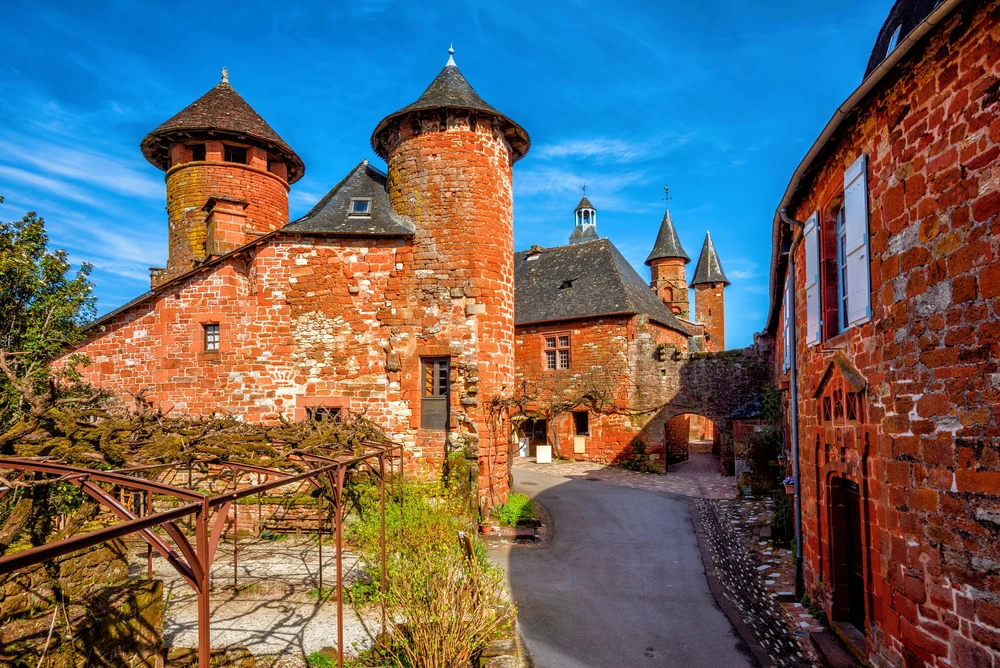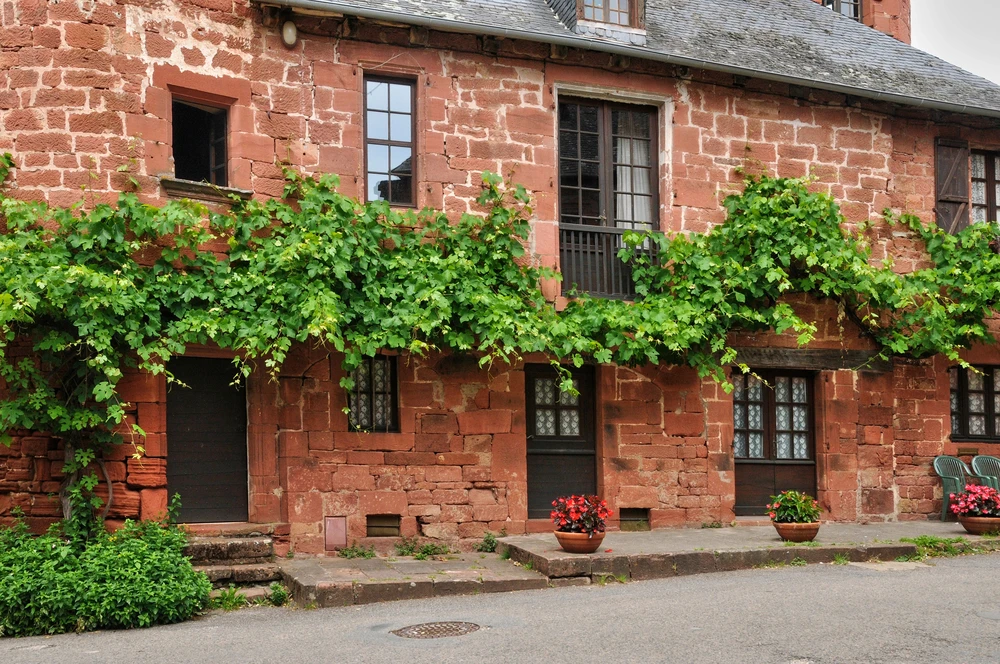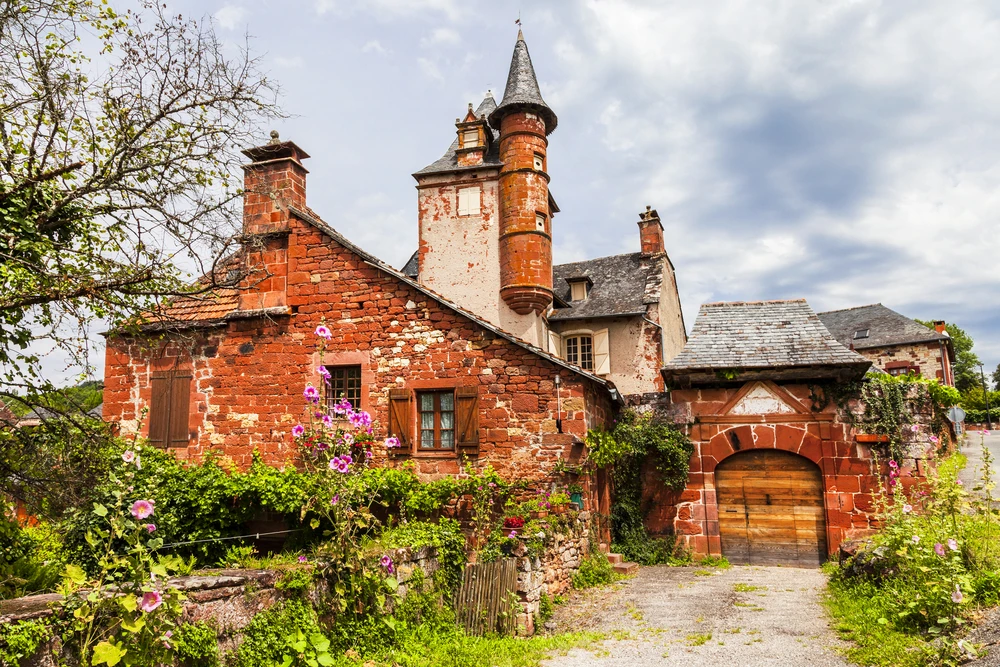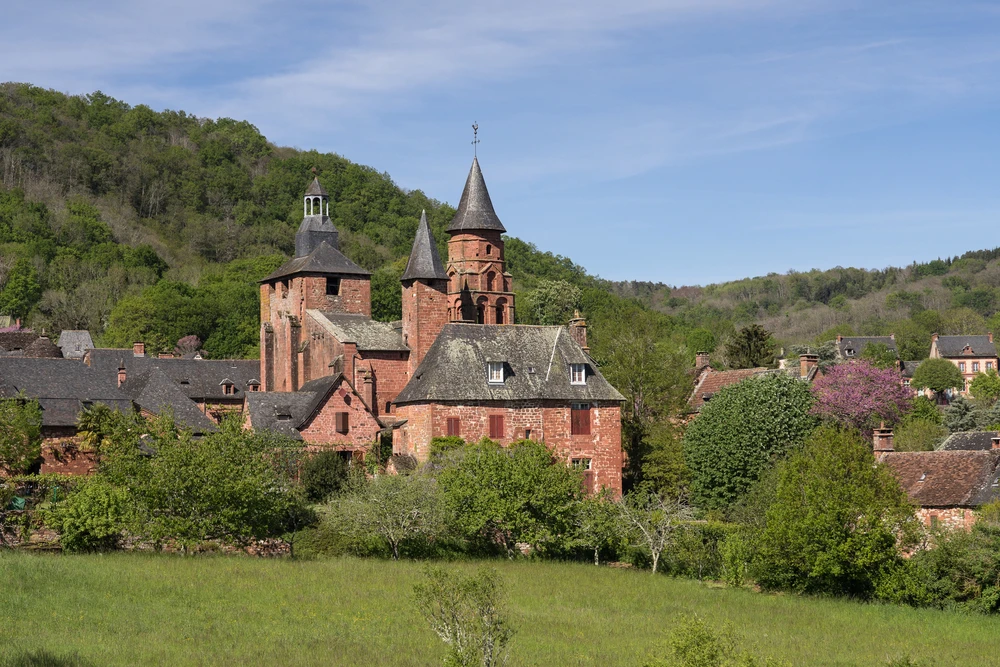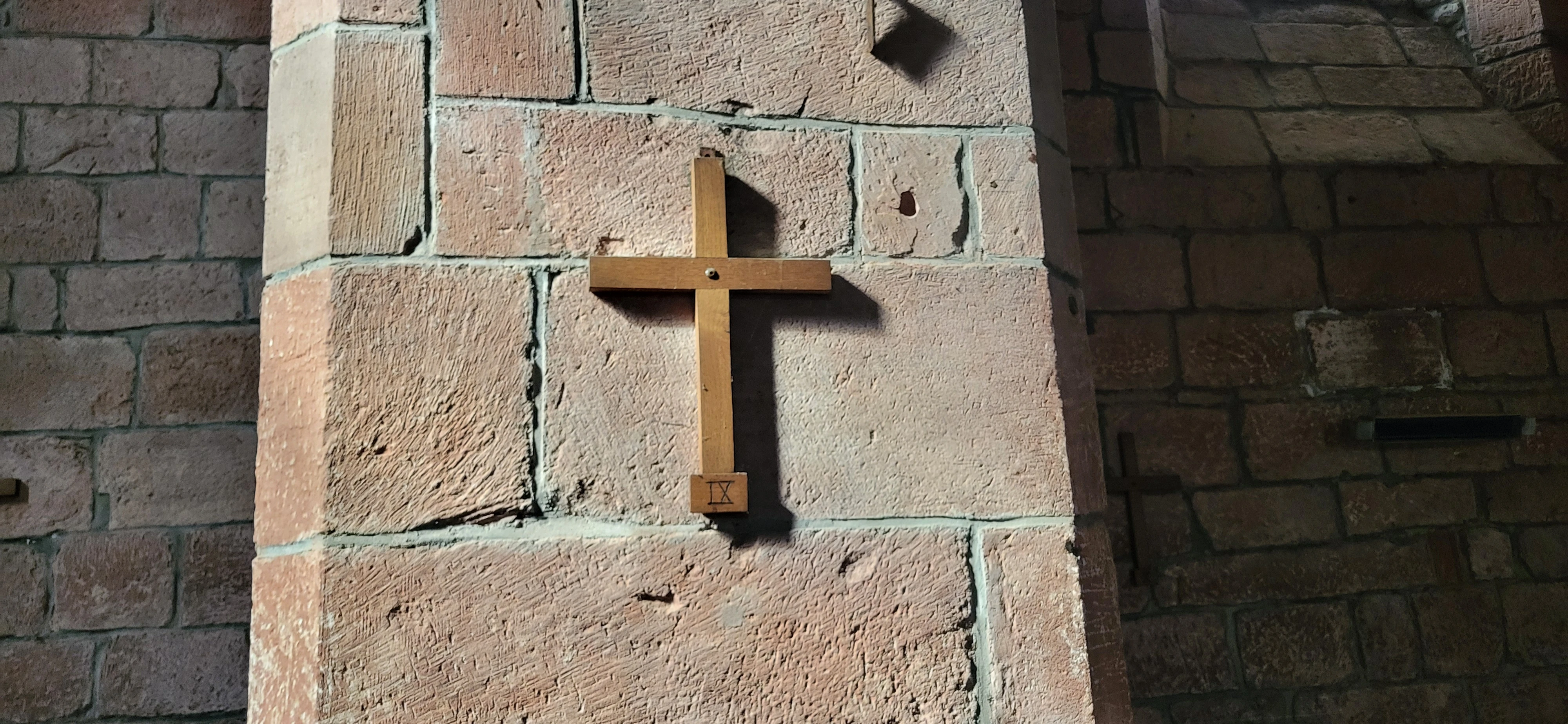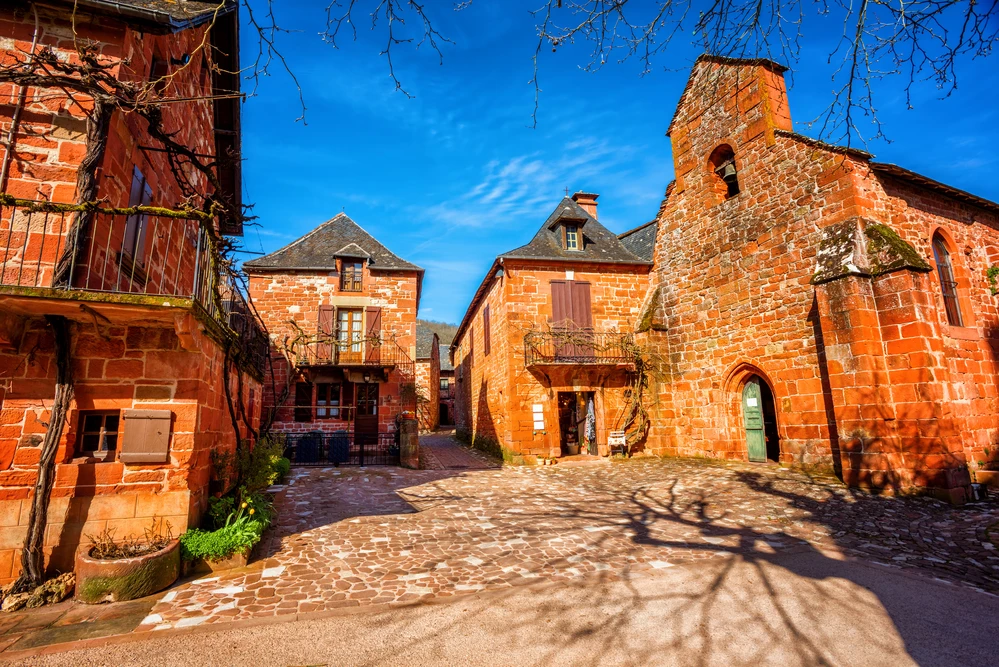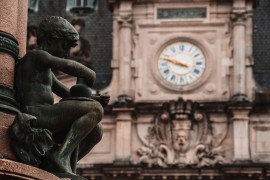I might as well be honest: there can be a few translation errors. Our translator tends to overdo the good stuff... And with so much good stuff around, we fear the worst. So bear with us!
Collonges la rouge and its houses ... red
When the stone here is unique, so is the village:
It's a village (population 500) on the edge of Quercy, in the Corrèze département. It's a tiny village, but one of the busiest tourist sites in the whole of the Limousin. It is officially one of the most beautiful villages in France, which makes sense since it was one of its mayors, Charles Ceyrac, who created the association and the list of the most beautiful villages in France in 1982. Collonges is obviously at the top of the list. You discover it below the road (you might even wonder where it is if you weren't a little bit attentive).Its streets wind their way down in a series of twists and turns around the astonishing church and are often hemmed in green by the vines that grow alongside the buildings or on the trellises to provide a little shade. The chataîgners enjoy themselves, as do the tourists, with the difference that the former are not just passing through and have been here, contemplating the village, for quite some time. There are plenty of little restaurants. From knives to plastic souvenirs, you can buy lots of knick-knacks if you feel like letting your hair down a bit.
Isn't the colour red amazing?And a few towers of red Collonges. Photo chosen by monsieurdefrance.com: Xantana via depositphotos
What's striking, then, is the red colour of all the houses in the village, including the church. The stone used here is very special: red sandstone. The village is entirely red, but that wouldn't make it one of the most beautiful villages in France if it weren't for something else.
The city of 25 towers.
What also makes Collonges la rouge so astonishingly beautiful is its architecture. On the way down, you'll be amazed at the number of towers jutting out from the roofs, piercing the blue (or grey, for that matter) Corrèze sky. These are "castels" as we say here, or fortified towers, and there are a lot of them, even if 25 is the figure for the glory days of Collonges, up until the 17th century. There are a few less now, 17 officially, but it's still impressive. I've been told that they are often towers with interior staircases. The more modest houses are no less elegant, their lintels often delicately carved to indicate a date, an emblem, sometimes a professional emblem. As a result of this astonishing number of beautiful houses, more than a third of Collonges ' surface area is listed as a historic monument or on the supplementary inventory of historic monuments. 609 hectares out of a total of 1431 is a huge amount, and well deserved.
The green of the vines gives rhythm to the facade and highlights the colour of the houses. Photo chosen by monsieurdefrance.com: packshot via dépositphotos.
What to see in Collonges la Rouge.
The village is partly fortified, and you'll discover two picturesque gates, the Priory Gate and the Flat Gate. Then, as you stroll through the streets, you'll come across numerous castels (fortified houses) and a few châteaux, including the Maison de la Sirène, with its mullioned windows and wooden corbels. Le Prieuré, with its balconies and roofs, La Maison des Soeurs (16th century), Maison Boutang du Peyrat, Maison Julliot and Maison Dey. Also worth seeingare the Poignet, Salvant and Vallat houses, at least part of the facade of which is a listed historic monument. The public buildings are beautiful and very old. Of particular interest are the former court house, the former town hall (the fireplace is impressive) and the Henri IV market hall (with its welcome shade in summer). In the chapel of the black penitents, which probably dates back to the 14th century, you'll find a small exhibitionpresenting the activities of the Société des amis de Collonges. This ancient association fights to promote and protect the town's heritage and has achieved a great deal.
One of the typical castles in Collonges la Rouge. Photo chosen by monsieurdefrance.Com: via depositphotos.
There are also a few châteaux, notably the Château de Vassinhac, in rue de la Garde (at the bottom of the village), which can be visited during the day (around 7.5 euros, to be checked on the spot) and which is also a bar and bed and breakfast (you can sleep there from 200 euros a night). It has a pretty garden, and the facade is well worth a visit.
The wonder of Collonges: the church of Saint Pierre
The magnificent church of Saint Pierre in Collonges la rouge: photo chosen by monsieurdefrance.com hzparisien@gmail.com via depositphotos.
It's hard to believe it's so old, but it's true: this 11th-century church of Saint Pierre in Collonges la Rouge is almost 1,000 years old. The sense of beauty and, above all, the boldness of the builders in the Middle Ages is truly impressive. They didn't have many tools or paper to draw on, and they set about building this massive church in red sandstone. Everything is stone, even the vaults. The bell tower is superb and very bold, starting with a square, on top of which is a hexagon, on top of which is the round roof. From the inside, when you look up, the shapes are superb and worthy of an art photograph. Another small bell tower was added in the 14th century at the entrance to the church to keep watch over the surrounding area (the watchman's bell tower). The tympanum at the entrance is truly magnificent, all white in contrast to the red church, and delicately carved. It depicts the Ascension. You can clearly see Christ, in magesty, holding a book, and the Virgin and 11 apostles. It is thought to have been carved by craftsmen from Toulouse in the 12th century. The porch was so beautiful that the local inhabitants protected it during the wars of religion in the 16th century, when the Huguenots, who condemned religious representations, destroyed statues, sculptures and paintings when they took over a town. The inhabitants of Collonge at the time had the idea of raising the sculpted porch and even hiding it. It was not restored to its original position until much later.
The interior of the church is all stone, with some beautiful wooden altars.It is a place of meditation: photo chosen by monsieurdefrance.com Jérôme Prod'homme (c)
The interior is sober and beautiful. It invites prayer. You can't help but be moved when you see the black plaque with the names of the children from Collonges la Rouge who died for France. The list is sadly long, and it helps us realise how the First World War bled the country dry, particularly the countryside, which was emptied long before the rural exodus began. A rural exodus that began early, in Collonges, since the Phyloxera epidemic that struck the French vineyards and destroyed them to the point where they had to be completely replanted, deprived the inhabitants of income and work. Many left, completing the decline of a town with a rich past. Collonges was justifiably proud of itself during these dark years, as the town council had a number of buildings listed as historic monuments in the 1900s, at a time when tourism was still a very, very long way off - the black gold of the little town today .
A brief history of Collonges la Rouge
Castles of Collonges. Photo chosen by Monsieurdefrance.com: packshot via depositphotos
It seems that the name Collonges comes from "colonica", meaning a place cultivated by a colonist, i.e. a free man. The turning point in Collonges' history was the creation of a priory in the 8th century. The priory attracted many villagers because it was a holy place that provided work and protection. The village was surrounded by ramparts and 4 gates and, as it grew, it became a place of rest and trade for pilgrims on their way to Rocamadour and Santiago de Compostela (and still is to some extent). The vineyards grew and, with them, the wealth of the village, which was said to supply the popes of Avignon with wine. In the 16th century, Collonges was relatively untouched by the Wars of Religion, but it has to be said that there was a surprising and very intelligent innovation here, as the church had two naves, one for Catholic worship and the other for Protestant worship. The two faiths live together in the same place. It makes you think! The 16th century was Collonges' heyday, when the nobles built the castles that are still there today. It has to be said that the town was an important part of the Viscounty of Turennes. They were cautious, however, as their houses were often equipped with échaugettes. Religious conflict was never far away, even with a church split in two. The end of the relative independence and tax privileges of the Viscounty of Turenne in the middle of the 18th century, followed by the French Revolution, which destroyed the priory, signalled the end of Collonges as an important town, before the end of the vineyards finished it off to the point where it became a stone quarry. Without the intelligence of the local council at the beginning of the 20th century, which protected the village and enhanced its beauty, we're not sure we'd be able to stroll, dream and admire the streets of Collonges la rouge, the very first of France's most beautiful villages.
The Chapelle des pénitents noirs in Collonges la rouge. Photo chosen by monsieurdefrance.Com: Xantana via depositphotos.
Collonges la rouge : Getting there / Website / Information
By road and rail.
Collonges la rouge is in the Corrèze department, formerly in the Limousin region, now in the Nouvelle Aquitaine region. It has a population of just under 500 .
There is a campsite located on the RD 38 in the commune.
Pay car parks are located at the entrances to the town (I saw two) and note that you pay on the way out (by typing in your licence plate number etc., so allow a little time for yourself and the little old man in front who doesn't understand a thing). There is an area for campervans.
It is about 1H15 (77 kms) from Limoges, the same from Brives la Gaillarde and about the same from Sarlat La Canéda (the road is winding and the scenery beautiful). 2H30 from Toulouse or Bordeaux and 5H15 from PARIS .
The nearest train station is Turenne (6 km).
Around Collonges la Rouge
Shopping is in Meyssac. In the Collonges area: Rocamadour, with its historic and religious site, and the monkey forest (150 monkeys). The Padirac chasm is not far away.
Websites :
The official Corrèze tourism website.

